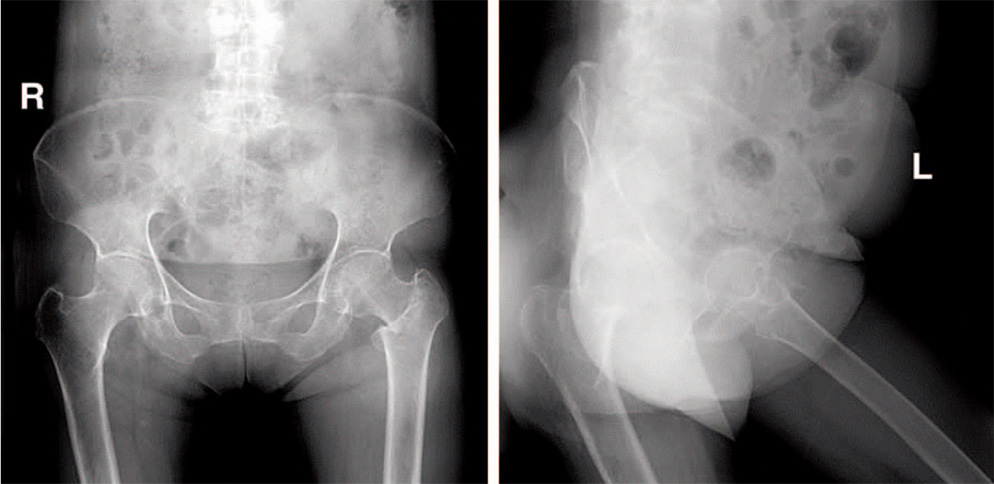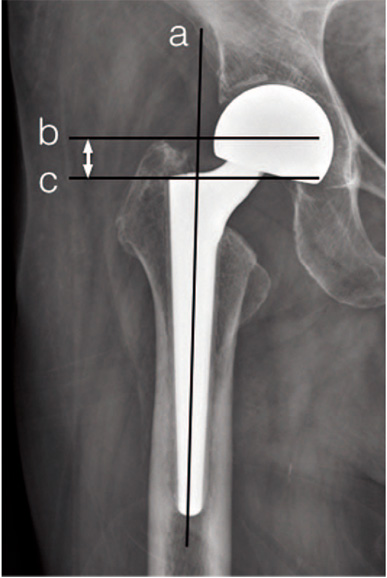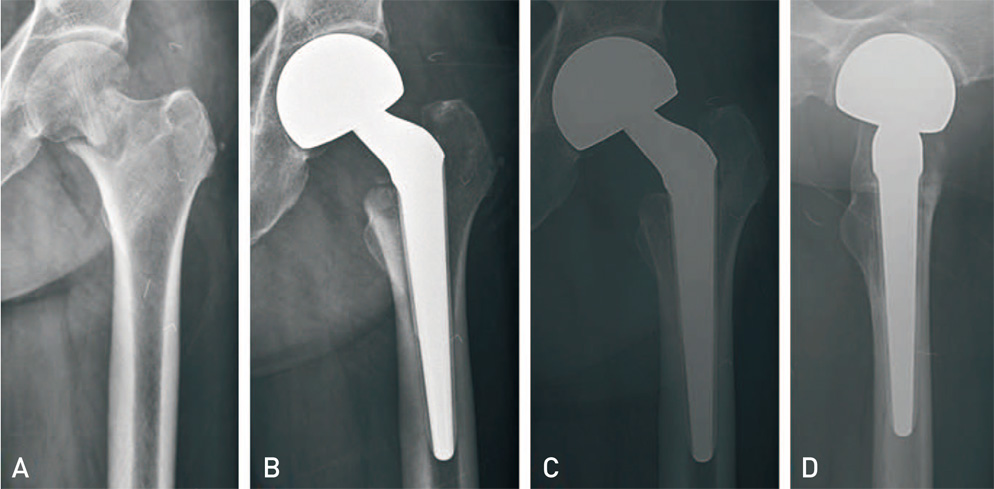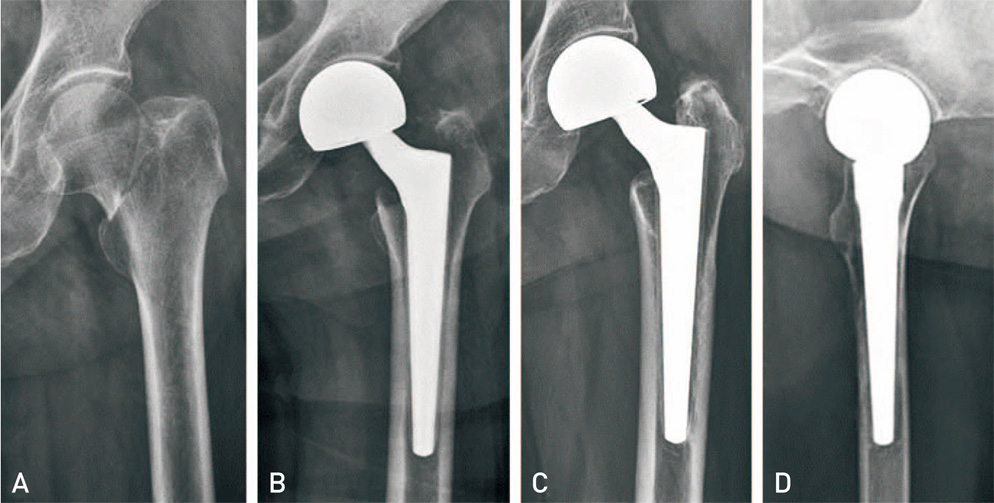Hip Pelvis.
2015 Dec;27(4):232-240. 10.5371/hp.2015.27.4.232.
Bipolar Hemarthroplasty Using Cementless Conical Stem for Treatment of Dorr Type B and C Femoral Neck Fracture
- Affiliations
-
- 1Department of Orthopaedic Surgery, College of Medicine, Chosun University, Gwangju, Korea. shalee@chosun.ac.kr
- KMID: 2150511
- DOI: http://doi.org/10.5371/hp.2015.27.4.232
Abstract
- PURPOSE
The current study aims to evaluate the clinical and the radiological outcome of bipolar hemiarthroplasty using cementless cone stem to treat osteoporotic femoral neck fracture and compare the results according to the proximal femur geometry.
MATERIALS AND METHODS
Seventy-five hips (75 patients) that underwent bipolar hemiarthroplasty with cementless cone stem between September 2006 and December 2011 were analyzed. The minimum follow-up period was 3 years. Thirty-three hips were classified as type B and 41 as type C. The clinical outcome was assessed using Harris hip score and the walking ability score. Radiographic evaluation was performed to evaluate the stability of the prosthesis.
RESULTS
At the most recent follow up, the mean Harris hip score was 86 (range, 70-92) and 65% recovered to preoperative ambulatory status. In the radiographic exam, stable stem fixation was achieved in all cases. For the complications, eight hips developed deep vein thrombosis while three hips showed heterotopic ossification. Dislocation and delayed deep infection occurred in one hip resepectively. There were no significance differences in Harris hip score and walking ability score when the type B group was compare with the type C.
CONCLUSION
Bipolar hemiarthroplasty with cementless cone stem showed an excellent early outcome both clinically and radiographically regardless of the shape of the proximal femur. We believe this prosthesis can provide early stability to the Dorr type B and C femur and is an effective treatment for treating osteoporotic femoral neck fracture.
MeSH Terms
Figure
Reference
-
1. Cuckler JM, Tamarapalli JR. An algorithm for the management of femoral neck fractures. Orthopedics. 1994; 17:789–792.
Article2. Khan RJ, MacDowell A, Crossman P, et al. Cemented or uncemented hemiarthroplasty for displaced intracapsular femoral neck fractures. Int Orthop. 2002; 26:229–232.
Article3. Hungerford DS, Jones LC. The rationale for cementless total hip replacement. Orthop Clin North Am. 1993; 24:617–626.
Article4. Dorr LD, Faugere MC, Mackel AM, Gruen TA, Bognar B, Malluche HH. Structural and cellular assessment of bone quality of proximal femur. Bone. 1993; 14:231–242.
Article5. Wagner H, Wagner M. Cone prosthesis for the hip joint. Arch Orthop Trauma Surg. 2000; 120:88–95.
Article6. Koval KJ, Skovron ML, Aharonoff GB, Meadows SE, Zuckerman JD. Ambulatory ability after hip fracture. A prospective study in geriatric patients. Clin Orthop Relat Res. 1995; (310):150–159.7. Gruen TA, McNeice GM, Amstutz HC. "Modes of failure" of cemented stem-type femoral components: a radiographic analysis of loosening. Clin Orthop Relat Res. 1979; (141):17–27.8. Engh CA, Bobyn JD, Glassman AH. Porous-coated hip replacement. The factors governing bone ingrowth, stress shielding, and clinical results. J Bone Joint Surg Br. 1987; 69:45–55.
Article9. Rothman RH, Hozack WJ, Ranawat A, Moriarty L. Hydroxyapatite-coated femoral stems. A matched-pair analysis of coated and uncoated implants. J Bone Joint Surg Am. 1996; 78:319–324.
Article10. Callaghan JJ, Dysart SH, Savory CG. The uncemented porous-coated anatomic total hip prosthesis. Two-year results of a prospective consecutive series. J Bone Joint Surg Am. 1988; 70:337–346.
Article11. Girard J, Roche O, Wavreille G, Canovas F, Le Béguec P. Stem subsidence after total hip revision: 183 cases at 5.9 years follow-up. Orthop Traumatol Surg Res. 2011; 97:121–126.
Article12. Zicat B, Engh CA, Gokcen E. Patterns of osteolysis around total hip components inserted with and without cement. J Bone Joint Surg Am. 1995; 77:432–439.
Article13. Brooker AF, Bowerman JW, Robinson RA, Riley LH Jr. Ectopic ossification following total hip replacement. Incidence and a method of classification. J Bone Joint Surg Am. 1973; 55:1629–1632.14. Bezwada HP, Shah AR, Harding SH, Baker J, Johanson NA, Mont MA. Cementless bipolar hemiarthroplasty for displaced femoral neck fractures in the elderly. J Arthroplasty. 2004; 19:7 Suppl 2. 73–77.
Article15. Charnley J. Total hip replacement by low-friction arthroplasty. Clin Orthop Relat Res. 1970; 72:7–21.
Article16. Middleton RG, Uzoigwe CE, Young PS, Smith R, Gosal HS, Holt G. Peri-operative mortality after hemiarthroplasty for fracture of the hip: does cement make a difference? Bone Joint J. 2014; 96-B:1185–1191.17. Cohen CA, Smith TC. The intraoperative hazard of acrylic bone cement: report of a case. Anesthesiology. 1971; 35:547–549.
Article18. Dandy DJ. Fat embolism following prosthetic replacement of the femoral head. Injury. 1971; 3:85–88.
Article19. Kienapfel H, Sprey C, Wilke A, Griss P. Implant fixation by bone ingrowth. J Arthroplasty. 1999; 14:355–368.
Article20. Carlsson AS, Nilsson BE. The relationship of bone mass and loosening of the femoral component in total hip replacement. Acta Orthop Scand. 1980; 51:285–288.
Article21. McLaughlin JR, Lee KR. Total hip arthroplasty with an uncemented femoral component. Excellent results at ten-year follow-up. J Bone Joint Surg Br. 1997; 79:900–907.22. Shon WY, Lee SH, Suh SW, Jeon SJ. The evaluation of proximal femur classification by Dorr as preoperative radiographic evaluation. J Korean Hip Soc. 1995; 7:79–86.23. Kho DH, Kim KH, Kim HJ, Kim DH. Bipolar hemiarthroplasty using calcar replacement stem for hip fractures in the elderly. J Korean Fract Soc. 2008; 21:232–239.
Article24. Hinchey JJ, Day PL. Primary prosthetic replacement in fresh femoral-neck fractures. A review of 294 consecutive cases. J Bone Joint Surg Am. 1964; 46:223–240.25. Campbell AC, Rorabeck CH, Bourne RB, Chess D, Nott L. Thigh pain after cementless hip arthroplasty. Annoyance or ill omen. J Bone Joint Surg Br. 1992; 74:63–66.
Article26. Faraj AA, Yousuf M. Anterior thigh pain after cementless total hip arthroplasty. Int Orthop. 2005; 29:149–151.
Article27. Engh CA, McGovern TF, Bobyn JD, Harris WH. A quantitative evaluation of periprosthetic bone-remodeling after cementless total hip arthroplasty. J Bone Joint Surg Am. 1992; 74:1009–1020.
Article28. Engh CA, Bobyn JD. Principles, techniques, results, and complications with a porous-coated sintered metal system. Instr Course Lect. 1986; 35:169–183.29. Wong M, Eulenberger J, Schenk R, Hunziker E. Effect of surface topology on the osseointegration of implant materials in trabecular bone. J Biomed Mater Res. 1995; 29:1567–1575.
Article30. Zhang J, Michalenko MM, Kuhl E, Ovaert TC. Characterization of indentation response and stiffness reduction of bone using a continuum damage model. J Mech Behav Biomed Mater. 2010; 3:189–202.
Article
- Full Text Links
- Actions
-
Cited
- CITED
-
- Close
- Share
- Similar articles
-
- Cementless Bipolar Hemiarthroplasty for Hip Fracture in Patients More than Seventy Years Old with Osteoporosis
- Comparison of Early Postoperative Stress Distribution around Short and Tapered Wedge Stems in Femurs with Different Femoral Marrow Cavity Geometries Using Finite Element Analysis
- Cementless Total Hip Arthroplasty Using the Conical Femoral Stem
- Bipolar Hemiarthroplasty with Cementless Femoral Stem for Unstable Intertrochanteric Fractures
- Comparative Study of Bipolar Hemiarthroplasty for Femur Neck Fractures Treated with Cemented versus Cementless Stem






